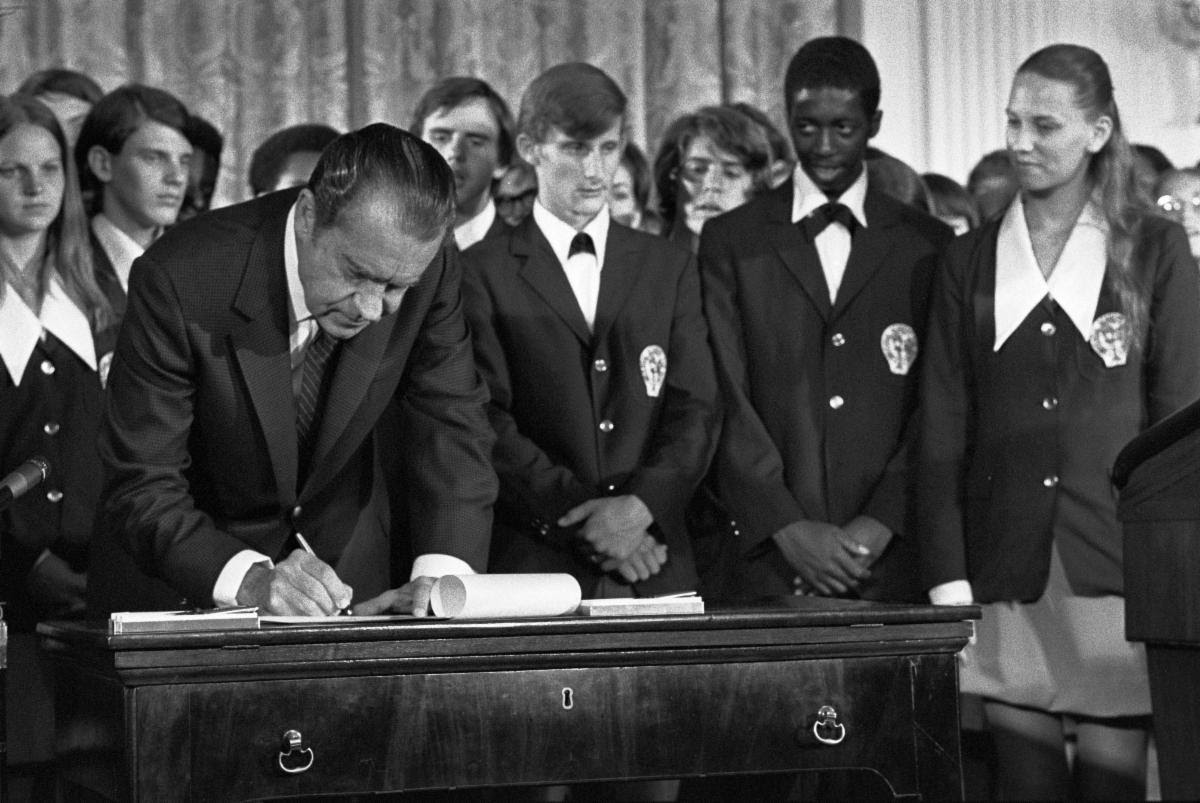Dear Educators,
The Education and Public Programs Team at the Nixon Library is pleased to remind you that the National Archives and Records Administration (NARA) continues to be an excellent source for entertaining and historical content! Simply follow the links below for additional information.
![]()
The 26th Amendment
Ratified in July 1971, the 26th Amendment to the United States Constitution lowered the voting age of U.S. citizens from 21 to 18 years old.
"...the right of citizens of the United States, who are eighteen years of age or older, to vote shall not be denied or abridged by the United States or by any State on account of age." Section I, Amendment 26 of the U.S. Constitution"

Joint Resolution proposing an amendment to the Constitution of the United States extending the right to vote to citizens eighteen years of age or older, Public Laws, 92nd Congress, 1st Session; General Records of the United States Government; Record Group 11. National Archives and Records Administration
Sentiment to lower the nation’s voting age dates back to WWII. As American involvement in the war increased, President Roosevelt sought to increase the size of the nation’s military and lowered the draft age of young men from 21 to 18 years old. Many were dismayed at the notion that if young men could fight and die for their country, they could not participate in its fundamental democratic process - voting. “Old enough to fight, old enough to vote” became a widespread slogan, eventually prompting a proposal for a constitutional amendment to give 18-year-olds the right to vote. The proposal, however, failed to gain political traction.

Secretary of War Henry Stimson is blindfolded as he draws the first number for the nation's first peacetime military draft lottery in Washington on Oct. 29, 1940. Behind the lectern at left is President Franklin D. Roosevelt, who was to announce the first number drawn. | AP Photo
"The eastern world it is explodin'
Violence flarin', bullets loadin'
You're old enough to kill but not for votin'"
-"Eve of Destruction” Song by Barry McGuire (1965)

Photograph 127-N-A371493: Vietnam...Marines riding atop an M-48 tank cover their ears as a 90mm gun fires during a road sweep southwest of Phu Bai: 4/3/1968; General Photograph File of the U.S. Marine Corps, 1927 - 1981; Records of the U.S. Marine Corps, Record Group 127; National Archives at College Park, MD. NAID 532483
By 1965, the United States became more heavily and directly involved with the war in Vietnam. Overall public support for the conflict began to wane considerably as American casualties rose. The conduct of the war increasingly came into question. By the end of the decade, anti-war protests were widespread as thousands of 18-year-old Americans were again being conscripted into military service to fight - and die - for their country. “Old enough to fight, old enough to vote,” the slogan first heard during World War II, was again adopted by student activists.

Demonstration for reduction in voting age, Seattle, 1969. Image courtesy of MOHAI, Seattle Post-Intelligencer Collection, 1986.5.50631, photograph by Tom Barlet.
A renewed emphasis on lowering the voting age to 18 again became a hot political topic. In April 1970, as part of legislation to extend the Voting Rights Act of 1965, Congress controversially lowered the voting age to 18. Although personally supportive of the issue, President Nixon felt it was the right of the states and not the federal government to set the voting age. President Nixon nevertheless signed the act, but in December of 1970, the Supreme Court ruled that Congress had overstepped its bounds. Fearing confusion as to who would be able to vote in the 1972 election, Congress quickly proposed and surprisingly passed a constitutional amendment permanently lowering the voting age to 18. Ratification of the amendment by the states was completed within four months - the fastest in ratification history.
On July 5th, 1971, in a ceremony in the White House East Room, in front of the 500-member choral group Young Americans in Concert, President Richard Nixon signed the certified amendment along with three selected 18-year-olds signing as witnesses.

On 7/5/1971, in a ceremony held in the East Room, the amendment was certified (signed) by the General Services Administrator, Robert L. Kunzig, followed by President Nixon and 18-year-old students from "Young Americans in Concert" (Julianne Jones, Joseph W. Loyd, Jr., and Paul S. Larimer) signing as witnesses. WHPO-6749-09A
Using DocsTeach, the National Archives’ online tool for teaching activities through primary resources, we invite you and your students to look further into how the 26th Amendment came to be through the teaching activity “Lowering the Voting Age: Nixon and the 26th Amendment.” This activity encourages students to think critically about the history and importance of the 26th Amendment that granted the right to vote to American citizens aged 18 or older.
Please feel free to contact us at NixonEducation@nara.gov if you have any questions.
Stayed tuned for regular updates from the Nixon Library Education and Public Programs Team.
Sincerely,
The Nixon Library Education and Public Programs Team

